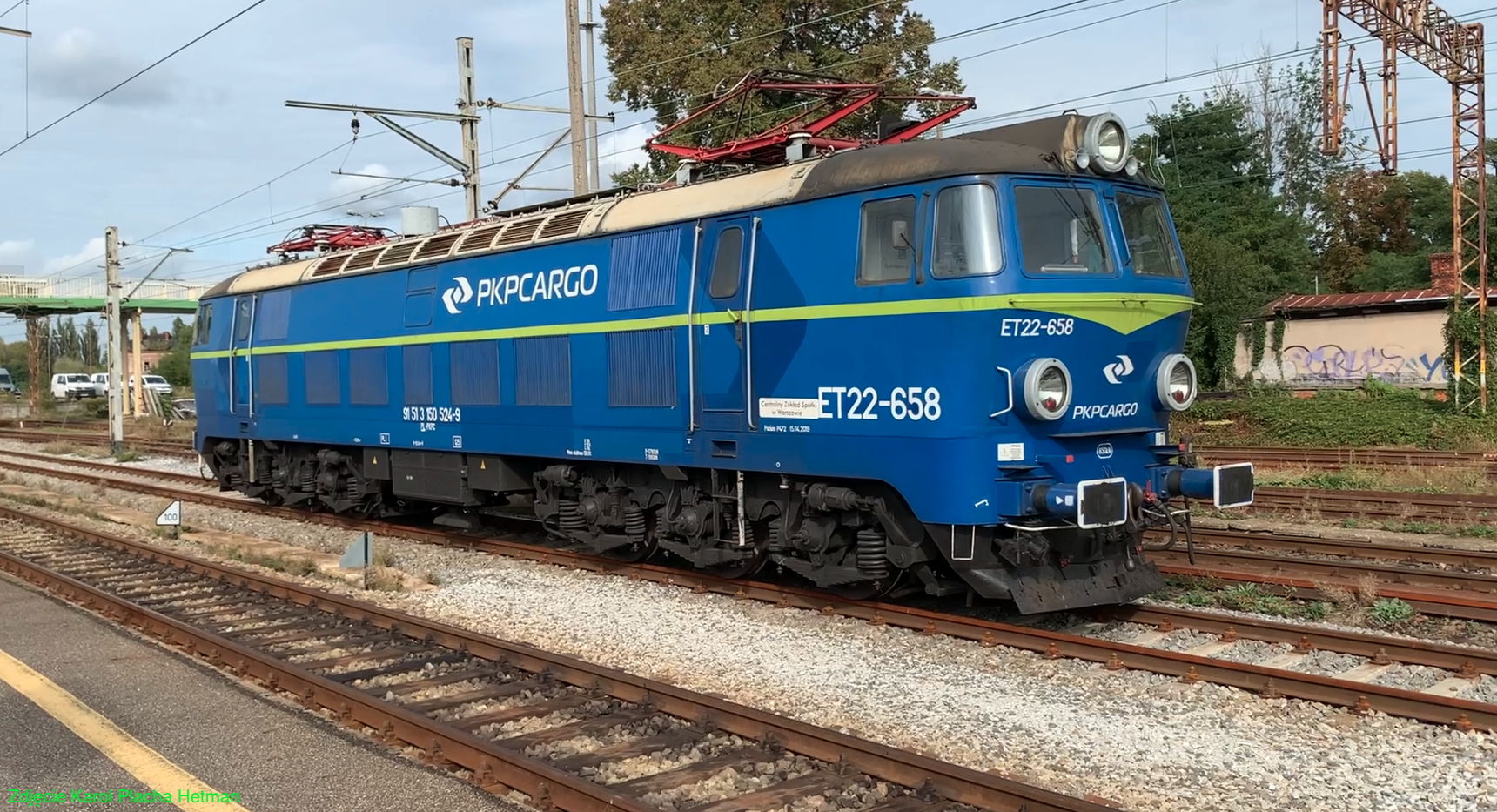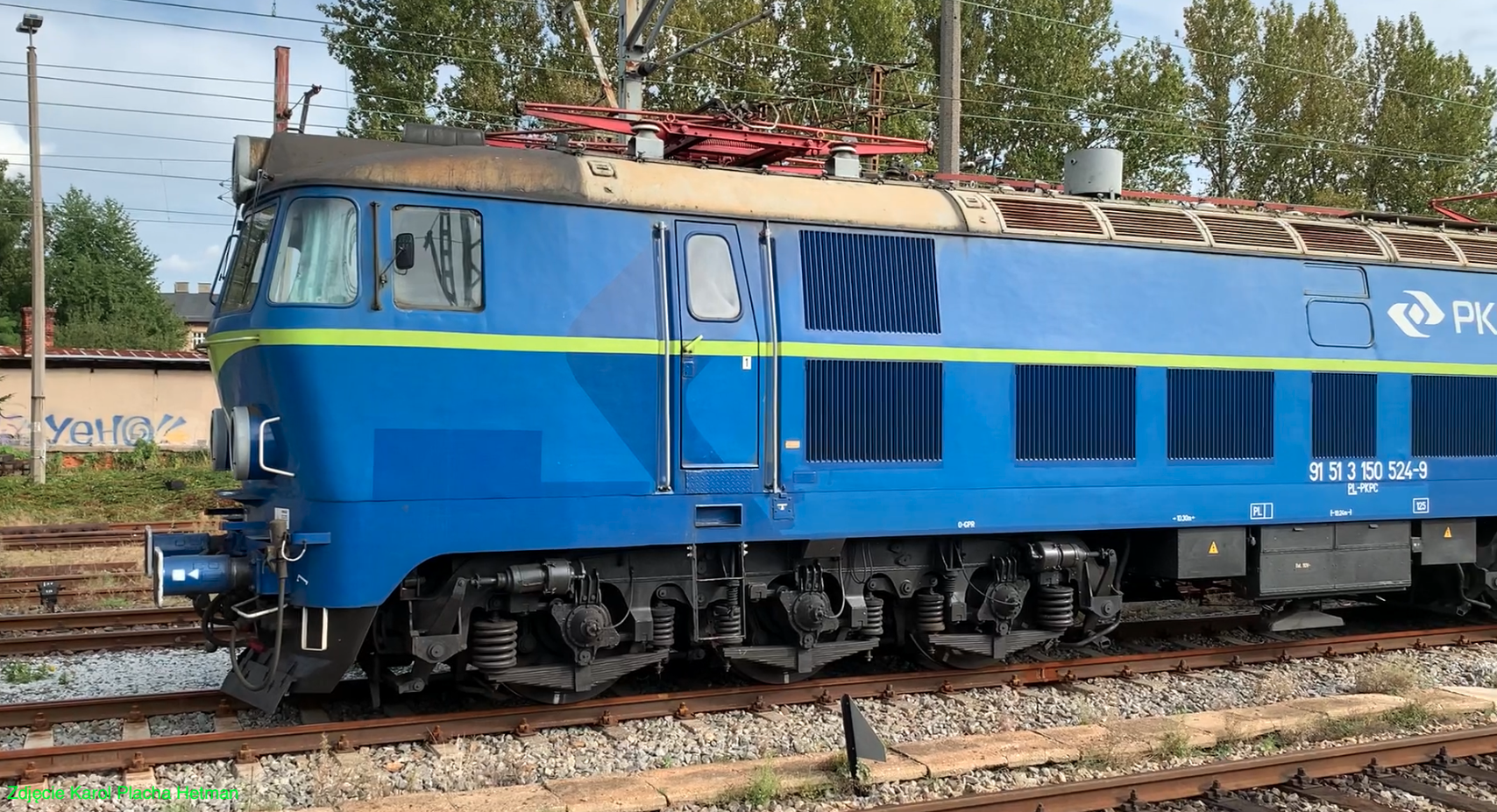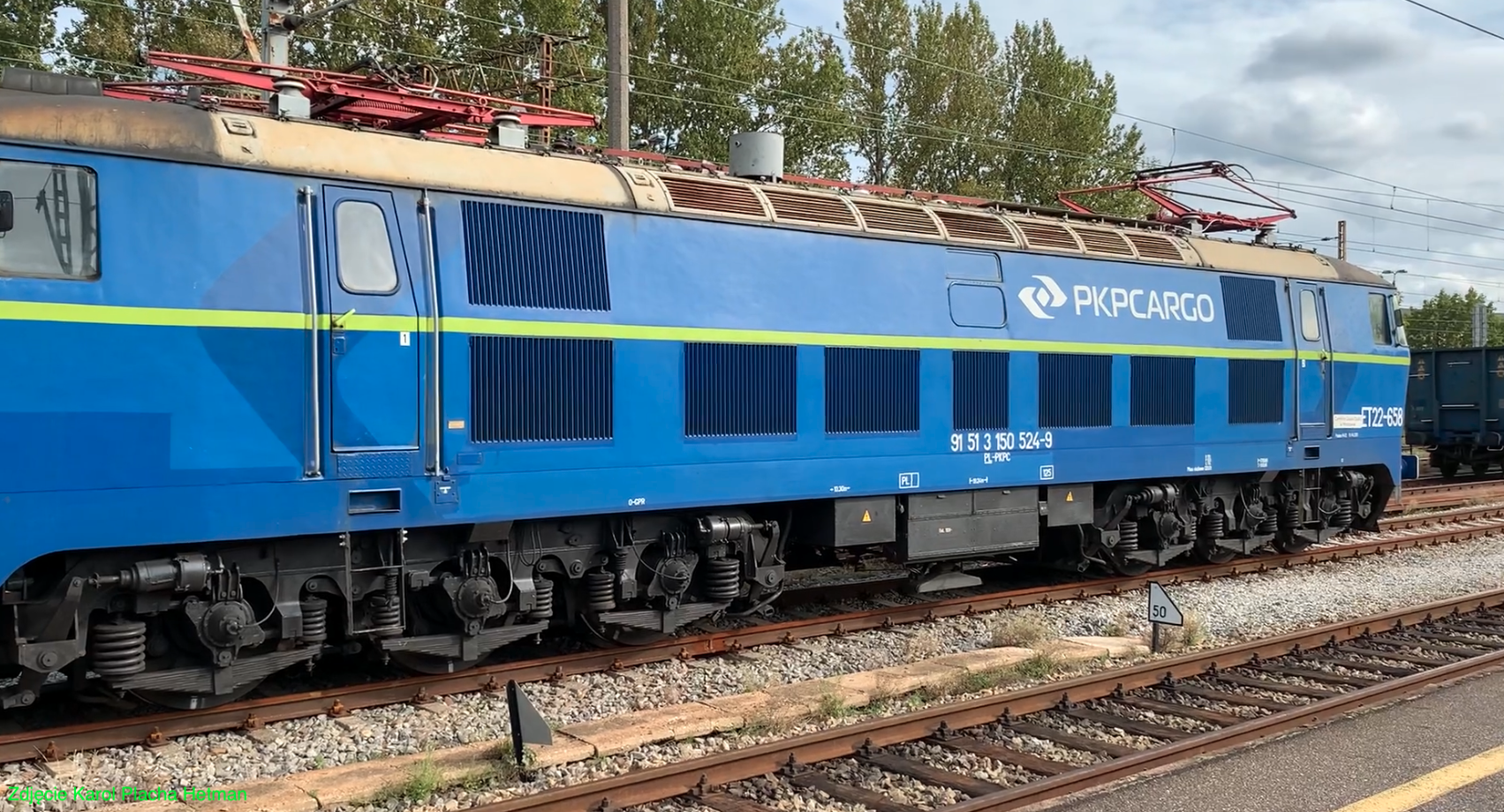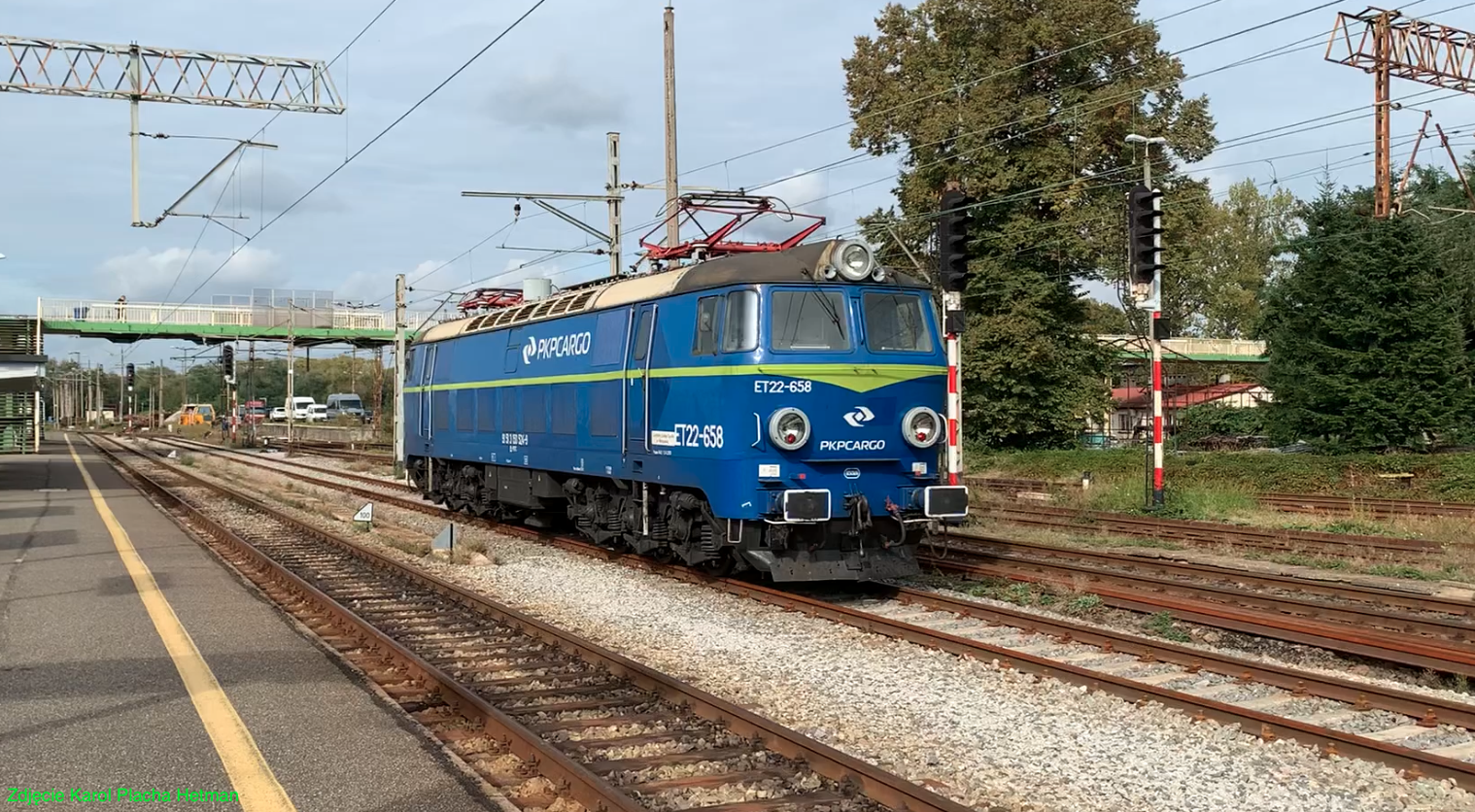Bielsko Biała 2023-10-17
Electric Locomotive ET22-658.




ET22 Electric Locomotives.
ET22 is a Polish heavy locomotive produced in the period 1969 - 1989, at the PaFaWag factory under the designation 201E. A total of 1,184 units were produced for PKP and 23 locomotives for Morocco.
The ET22 locomotive was developed in the railway construction office in Poznań. The project was based on experience from the operation of ET-21 locomotives, which had been in use since 1957. The locomotive was initially designated 7E and was eventually designated 201E. Due to the long production period, the locomotive was subject to several modifications. Until 2001, ET22 locomotives were used by PKP, and in 2001, as a result of changes, they all went to PKP Cargo. In the following years, many locomotives were transferred to other carriers operating in Poland. Since 2005, some ET22 units can run on Czech and Slovak railways.
Construction development.
In 1964, the Central Design Office of the Rolling Stock Industry, currently the Rail Vehicles Institute in Poznań, began developing a new heavy electric locomotive. To speed up the work and use existing solutions and components, the 4E (EU07) design was used. The designers saw the future locomotive as universal, not just a freight locomotive. The final decision was made by the party authorities in Warsaw - it will be ET22. In 1966, the project received the designation 7E. During the works, the designation was changed to 201E. The PaFaWag plant in Wrocław was designated as the manufacturer. The first two prototypes were also built there: ET22-001 and 002. The prototypes were sent to the Kraków Prokocim locomotive depot for testing.
In 1971, the first 10 serial ET22 locomotives (003 - 012) were built. At the same time, production of ET21 locomotives was ended. About 90 locomotives were built annually. In the period 1975–1976, PaFaWag produced 23 type 201Eg (ET22) locomotives for Morocco. A total of 1,207 electric locomotives were built.
In the period 1971 - 1973, experiments were carried out on changing the gear ratios of electric motors. They wanted to obtain a freight electric locomotive with a design speed of 125 km/h and a fast electric locomotive with a speed of 160 km/h. In 1978, a modernized suspension of the locomotive body was developed.
Despite the possibility of running in double traction, ultimately the ET22 locomotives did not cooperate with each other. Their high power caused electrical equipment in the second locomotive to burn and the screw couplings to break. This was practically the end of the possibility of assembling trains from wagons of that time. Due to its high tractive power, the electric locomotive is commonly called "Bull".
By 1997, 33 ET22 locomotives were removed from service. By 2000, another 192 electric locomotives were removed from the state. This does not mean, however, that all locomotives were scrapped. Many of them are waiting for better times. When the PKP Cargo company was established in 2001, it took over 955 ET22 locomotives, i.e. all of them, including the EU07. Since PKP IntrCity did not have any locomotives, it had to sublease locomotives from PKP Cargo. As a result, passenger trains often pulled ET22 electric locomotives, which was not inappropriate due to the characteristics of the ET22.
At the beginning of the 21st century, there was a need to modernize the existing electric locomotives. In 2004, one locomotive was modernized in Gliwice, which, after tests, became a prototype for the modernization of subsequent electric locomotives. Since 2007, subsequent locomotives have been rebuilt. Several dozen ET22 locomotives were modernized.
From 2010, ET22 locomotives were transferred to other carriers in the country.
In 2007, the first ET22 locomotive entered the Czech Republic. In 2008, the first locomotive entered the routes in Slovakia. In 2016, PKP Cargo had 24 ET22 series locomotives approved for traffic in the Czech Republic.
ET22 design.
The box and the frame are a single, self-supporting structure made of welded steel. The sides of the box at the top are inclined towards the center to maintain the gauge dimensions, similar to the SU45 locomotive. The roof in the central part is removable for easier operation. There are two pantographs on the roof. The locomotive starts and ends with the driver's cabins. The machinery space consists of three parts. The high voltage compartment is located in the central part of the electric locomotive. The locomotive has two three-axle bogies. Each trolley has three EE541 engines. The total continuous power is 3 MW. The engine gear ratio is 79:18. The locomotive pulls trains weighing up to 3,500 tons.
ET22 locomotives for PKP were standardly painted light green and dark green. The bogies and other equipment below the locomotive stand were painted black. In the period 1989 - 1999, the fronts of the locomotives were painted yellow. The frontage of the refuge was painted red.
During mass production, the appearance of the sides of the locomotive body changed. Generally there were two side designs. First pattern; There is no air catch shutter in the upper part. There are 4 ventilation louvers on the sides. Halfway along the length of the locomotive there is one double window, the upper section of which opens. Additionally, there are two non-opening windows that illuminate the interior of the engine room. The entrance doors to the locomotive are in the sides on each side and are set away from the front of the locomotive. There are windows in every door. Each cabin is equipped with 6 windows; two front, two in the corners and two on the sides. Round, regular headlights. During the renovations, the headlights were converted to the so-called ZEZ. Some locomotives received bumper covers.
The second design of the locomotive sides: There are 7 air catch louvers in the upper part. There are another 9 ventilation louvers on the sides. Halfway along the length of the locomotive there is one double window, the upper section of which opens. The entrance doors to the locomotive are in the sides on each side and are set away from the front of the locomotive. There are windows in every door. Each cabin is equipped with 6 windows; two front, two in the corners and two on the sides. Round, regular headlights.
Data T-T ET22:
Co'Co' axis system. Length 19.24 m. Width 3.00 m. Height 4.46 m. Service weight 120,000 kg. Axle load 20,000 kg. Wheel diameter 1.25 m. Electric power supply 3,000 V. Motor type EE541. Engine gear 79:18. Design speed 120 km/h. Oerlikon type braking system. The locomotive pulls trains weighing up to 3,500 tons.
Electric locomotive ET22-658.
The ET22-658 electric locomotive, factory number 201E-658, No. 91 51 3 150 524-9 (PL-PKPC), was built in 1981. The locomotive body was made as the second pattern.
The locomotive began service in March 1981 in MD Piotrków Trybunalski. The locomotive was painted olive green. From July 1997, the locomotive served in MT / MZ / Rolling Stock Plant Łódź. In 2001, the locomotive was handed over to PKP Cargo branch in Łódź. In August 2004, the locomotive underwent an R5 level revision repair and was repainted green. The repair was carried out by ZNTK Oleśnica. In 2011, at the PKP Cargo Tabor Ostrów Wielkopolski plant, the P4 level was repaired and the locomotive was repainted blue with a light green stripe. In July 2014, the locomotive was transferred to PKP Cargo Centralny Zakład Zakłady w Warszawie. In March 2015, the locomotive was in PKP Cargo S.A.- Centrala. In July 2017, again at the PKP Cargo Central Plant of the Company in Warsaw. In April 2019, a P4 level repair was carried out at the PKP CARGO plant - the Company's West Plant. In October 2023, the locomotive still had regular headlights and was in service.
Written by Karol Placha Hetman
